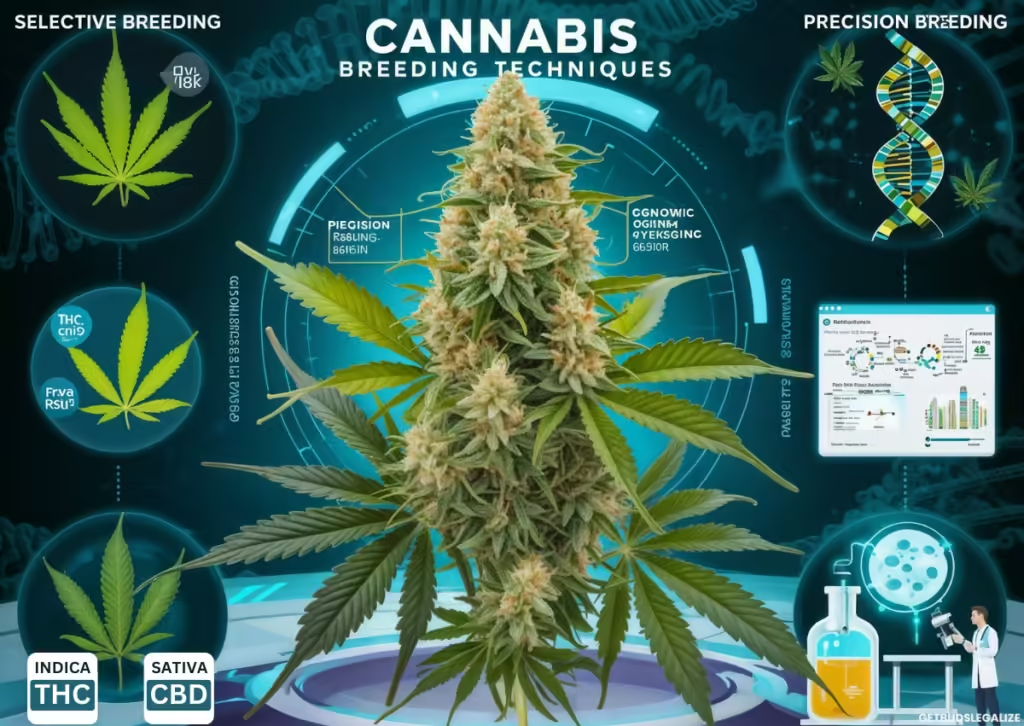Tracing the History of Cannabis Strains: How Ancient Landraces Shaped Today’s Hybrids
The journey of cannabis strains is a rich and fascinating tale that spans from the untamed wilds of ancient landrace strains to the meticulously bred hybrids of today. This evolution highlights the cultural significance of cannabis throughout history and showcases the advanced breeding techniques that have transformed the modern cannabis landscape.
In this article, we will delve into the history of cannabis strains, explore the foundational role of landrace strains, chart Amsterdam’s rise as the birthplace of cannabis hybrids, and examine the revolutionary breeding techniques that continue to shape the future of cannabis strains. Join us as we uncover the stories and innovations that have made cannabis a vital part of human culture!
A Brief History of Cannabis: From Ancient Civilizations to Modern Use

The Origins of Cannabis: Ancient Asia and Beyond
Cannabis has been intertwined with human civilization for over 5,000 years. Its earliest known use dates back to ancient Central Asia, where it was cultivated for various purposes, from textiles to traditional medicine.
Archaeological evidence from China indicates that by 2700 BCE, cannabis was already being utilized in early herbal practices for its fibers, seeds, and medicinal properties.
As cannabis spread westward and into other regions, its uses diversified. Ancient civilizations, including the Egyptians and Scythians, embraced cannabis for both medicinal and spiritual purposes.
Over time, this dispersion led to the development of unique strains that adapted to different climates and cultures, eventually laying the groundwork for the landraces that form the foundation of modern cannabis breeding.
Cannabis in the Pre-Modern Era: A Global Spread
With the expansion of global trade routes, cannabis followed suit. By the time the plant reached the Middle East, Africa, and Europe, it was being used for everything from religious ceremonies to early pharmacology.
In India, cannabis became deeply ingrained in religious practices and was referenced in ancient texts like the Atharva Veda. Meanwhile, in Africa, cannabis established itself as an essential plant for medicinal and spiritual purposes.
This global spread gave rise to what we now recognize as landrace strains—cannabis plants that evolved in specific regions, developing unique characteristics based on their environments and the cultures that cultivated them.
Landrace Strains: The Foundation of Cannabis Breeding

What Are Landrace Strains?
Landrace strains are the original, naturally occurring cannabis varieties that have evolved over centuries in specific geographic regions, untouched by human intervention.
These strains are genetically stable, ensuring their traits remain consistent across generations. As the purest forms of cannabis, they form the genetic backbone of modern hybrid strains.
Key Characteristics of Landrace Strains
- Genetic Stability: Landrace strains have adapted to their native environments over centuries, resulting in consistent and predictable genetic traits.
- Unique Terpene Profiles: The environmental factors in their regions of origin—such as soil, climate, and altitude—contribute to distinct terpene profiles that define the aroma and flavor of these strains.
- Cultural and Historical Significance: Many landrace strains are tied to the cultural practices of the regions they originate from. For instance, Hindu Kush from Afghanistan and Acapulco Gold from Mexico hold deep historical and cultural relevance in their respective areas.
The Importance of Landraces in Modern Cannabis
Landrace strains are crucial for preserving cannabis’s genetic diversity. In today’s highly commercialized hybrid world, these strains offer a pure genetic line, free from human manipulation. They are essential for creating stable new hybrids that can meet the demands of changing climates, resist pests and diseases, and provide more consistent effects for medical and recreational use.
Famous Landrace Strains: The Originals That Shaped Cannabis History

Notable Landrace Strains from Around the World
Throughout history, certain landrace strains have gained legendary status due to their unique characteristics and deep cultural significance. Some of the most famous landrace strains include:
1. Hindu Kush (Afghanistan/Pakistan)
Originating from the rugged mountains of the Hindu Kush region, this pure indica strain is renowned for its sedative effects and rich, earthy flavor. Hindu Kush has become a cornerstone of many modern Indica-dominant hybrids, valued for its resilience in harsh environments.
2. Acapulco Gold (Mexico)
This sativa landrace strain from Mexico is celebrated for its energizing effects and sweet, spicy aroma. Acapulco Gold gained fame in the 1960s and 70s as one of the best cannabis strains available, remaining a symbol of vibrant cannabis culture in North America.
3. Durban Poison (South Africa)
Known for its clear-headed and uplifting effects, Durban Poison is a pure sativa landrace strain from South Africa. Its sweet, citrusy flavor makes it a popular choice for daytime use, prized by those seeking creativity and focus.
4. Thai (Thailand)
This landrace sativa strain hails from the tropical jungles of Thailand, known for its distinct fruity and floral flavor combined with an energetic high. Thai strains played a pivotal role in developing many well-known hybrids, such as Haze.
5. Panama Red (Panama)
A legendary strain from Central America, Panama Red is a pure sativa landrace known for its potent, psychedelic effects. Recognized for its vibrant red coloration and slow-growing nature, it was a popular choice during the 1960s and 70s.
6. Malawi Gold
Malawi Gold is a highly sought-after sativa landrace strain from the African country of Malawi. Known for its long-lasting, energetic sweet, fruity flavors, Malawi Gold has a reputation as one of the finest cannabis strains in Africa. This strain is prized for its uplifting effects and resilience to outdoor cultivation in tropical climates, making it a favorite among growers and consumers alike.
These landrace strains serve as the building blocks of modern cannabis, providing the genetic foundation for many of the hybrids enjoyed today. By preserving and utilizing these strains, breeders can continue to create innovative new varieties while honoring the cultural heritage of cannabis.
Amsterdam: The Birthplace of Modern Cannabis Hybrids

The Rise of Cannabis Culture in Amsterdam
Amsterdam has long been synonymous with cannabis culture. The city’s open-minded and progressive approach to cannabis use, which began in the 1970s, created the ideal breeding ground for cannabis innovation.
The introduction of coffee shops provided a safe space for consumers to legally purchase and enjoy cannabis while allowing breeders to exchange knowledge and experiment with new strains.
The Role of Coffee Shops in Cannabis Innovation
Coffee shops in Amsterdam became informal research centers where consumers and breeders interacted. This unique environment fostered collaboration and creativity, allowing patrons to provide direct feedback on their experiences with various cannabis strains.
As consumers expressed their preferences for desired effects, flavors, and growth characteristics, breeders were encouraged to develop new strains that met these demands. This open culture of experimentation played a crucial role in driving the hybridization movement.
Breeders focused on creating strains that emphasized potency, flavor, and faster growth cycles, leading to a vibrant and diverse cannabis scene that continues to thrive today.

How Landrace Strains Found Their Way to Amsterdam
In the early 1970s, pioneering breeders began importing landrace strains from regions like Afghanistan, Thailand, Colombia, and Mexico. Visionaries such as Nevil Schoenmakers, known as the “King of Cannabis,” played a pivotal role in this process by introducing Afghan Indicas and Thai Sativas to Amsterdam, providing breeders with the genetic material needed to create some of the first cannabis hybrids.
The Impact of Early Breeding Pioneers
Amsterdam became a breeding hub for cannabis, thanks to early pioneers and seed banks such as:
- Sensi Seeds: One of the oldest and most respected seed banks, famous for iconic strains like Skunk #1 and Northern Lights.
- Green House Seeds: Founded by Arjan Roskam, this seed bank is known for award-winning hybrids like White Widow and Super Lemon Haze.
- DNA Genetics: Known for their innovative hybrids like Chocolope and Tangie, which introduced new flavor profiles and effects.
These breeders helped shape the cannabis landscape not only in Amsterdam but globally, setting the foundation for the modern hybrids we see today.
Modern Breeding Techniques: Shaping the Future of Cannabis

Advanced Techniques in Cannabis Breeding
The advent of modern breeding techniques has allowed for unprecedented control over cannabis genetics. Breeders can now precisely manipulate traits to meet consumer demand for more potent, flavorful, and consistent strains. Some of the most significant techniques include:
- Selective Breeding: This traditional method involves choosing parent plants with specific traits, such as high THC or CBD levels, fast flowering times, or unique terpene profiles, and breeding them to produce offspring with those traits. Selective breeding focuses on improving qualities like yield, potency, and flavor.
- Precision Breeding (Marker-Assisted Selection): This technique uses genetic markers to identify traits at the DNA level, allowing breeders to select plants with desired genes before they even grow. This results in faster, more accurate breeding and ensures consistency in strain characteristics.
- Genomic Sequencing: This involves analyzing the entire genome of cannabis plants to identify genes associated with desirable traits. By understanding the genetic basis of traits like cannabinoid content, disease resistance, and growth patterns, breeders can make more informed decisions during the breeding process.
- CRISPR Gene Editing: CRISPR technology allows for precise editing of the cannabis plant’s DNA. This groundbreaking method can create new strains by adding, removing, or modifying specific genes. Although still in the early stages of cannabis research, its potential includes higher yields, better resistance to pests, and custom cannabinoid profiles.
- Hybridization: This involves crossing different cannabis strains, such as indica and sativa, to create hybrids that blend the best traits from both parent plants. Hybridization is key to developing new strains with balanced effects, unique flavors, and targeted medicinal benefits.
The Evolution of Hybrid Strains
Thanks to modern breeding techniques, hybrid strains now dominate the global cannabis market. These hybrids combine the best traits of both indica and sativa landrace strains, offering a wide range of effects.
From relaxing body highs to uplifting cerebral experiences, hybrid strains cater to various user preferences. Iconic hybrids like Girl Scout Cookies, Gelato, and OG Kush exemplify how breeding has evolved to meet the diverse needs of both medical and recreational users.
The Future of Cannabis Strains: What Lies Ahead

Emerging Trends in Cannabis Breeding
As cannabis culture continues to evolve, several trends are shaping the future of cannabis strains:
- Focus on Cannabinoid Profiles: With the rise of CBD and other cannabinoids, breeders are creating strains that emphasize these compounds. This includes high-CBD strains tailored for therapeutic effects without the psychoactive experience of THC.
- Terpene-Enhanced Strains: Breeders are paying more attention to terpenes, the compounds responsible for cannabis aroma and flavor. By selectively breeding for specific terpenes, they aim to enhance the sensory experience and therapeutic effects of cannabis.
- Sustainability in Breeding: As environmental concerns grow, breeders are increasingly focusing on sustainable practices, such as organic cultivation, regenerative agriculture, and minimizing waste in the breeding process. This trend is essential for ensuring the long-term viability of cannabis cultivation.
- Customized Strains: Advances in genetics and breeding techniques will allow for more personalized cannabis experiences. Consumers may eventually be able to request custom strains tailored to their individual preferences and therapeutic needs.
Conclusion: The Evolution Continues
The history of cannabis strains is a testament to the resilience and adaptability of this remarkable plant. From its ancient landrace origins to the innovative hybrids of today, cannabis has undergone a transformative journey shaped by culture, environment, and human ingenuity.
As we look to the future, the continued exploration of cannabis genetics promises to yield new strains that cater to diverse preferences, therapeutic needs, and cultural practices.
By respecting the rich heritage of landrace strains while embracing modern breeding techniques, we can ensure that cannabis remains a vital part of human history and culture for generations to come.
FAQs About The History of Cannabis Strains
Landrace strains are pure cannabis varieties that have developed naturally in specific geographical regions. Over centuries, these strains have adapted to their unique environments without human intervention, leading to distinct characteristics and remarkable resilience.
Landrace strains are vital for modern cannabis breeding as they provide stable, pure genetic lines. These unaltered strains serve as a foundational resource for breeders looking to create new hybrids.
By utilizing landrace strains, breeders ensure genetic diversity, which is crucial for developing resilient cannabis varieties.
Additionally, landrace strains offer essential traits such as potency, disease resistance, and unique flavors, making them indispensable in the pursuit of innovative cannabis cultivation.
Hybrid strains combine the characteristics of both indica and sativa strains, providing a balanced experience.
They cater to various consumer preferences, offering effects that can range from relaxation and pain relief to increased energy and creativity.
Modern cannabis breeding techniques, such as CRISPR gene editing and marker-assisted selection, enable breeders to develop new cannabis strains with greater precision.
These methods specifically target traits, enhancing consistency in characteristics like THC and CBD levels. Additionally, they allow for the development of unique terpene profiles, contributing to the distinct flavors and effects of cannabis strains.
Amsterdam became the epicenter of cannabis hybrids due to its progressive policies established in the 1970s, which promoted the open cultivation and use of cannabis.
The city’s coffee shops provided ideal environments for breeders to experiment with landrace strains from around the globe. This vibrant atmosphere fostered creativity and innovation, leading to the creation of renowned hybrids like White Widow, Northern Lights, and Super Skunk.
- Indica strains are known for their relaxing, body-centered effects, making them suitable for pain relief, anxiety reduction, and sleep enhancement.
- Sativa strains offer uplifting, cerebral effects that are popular for daytime use and creative activities.
- Hybrid strains combine traits from both Indica and Sativa, offering a versatile range of effects tailored to user preferences.
Modern cannabis breeding techniques include selective breeding, backcrossing, and genomic sequencing.
These methods allow breeders to manipulate cannabis genetics precisely, producing strains with desired traits such as higher THC or CBD levels, unique terpene profiles, and improved resistance to pests and diseases.
The future of marijuana strains will focus on continued innovation and specialization. As the demand for medical cannabis increases, breeders are developing strains with higher CBD content and tailored cannabinoid profiles for specific therapeutic uses.
Sustainability is becoming a priority in the industry, with efforts to create strains that require fewer resources and have less environmental impact.
Additionally, consumers are seeking weed strains that deliver customized effects tailored to their needs, whether for relaxation, focus, or creativity.
Cannabis is thought to have originated in Central Asia, specifically in what is now Mongolia and China. The earliest known evidence of cannabis use dates back to around 5000 BCE, when it was employed for various purposes, including fiber for textiles, food, and medicinal applications. Over the centuries, cannabis spread worldwide, adapting to diverse climates and cultures.
The history of modern medical cannabis dates back thousands of years, with ancient civilizations using the plant for therapeutic purposes.
Historical texts from China, India, and Egypt highlight the use of cannabis in traditional medicine to treat ailments such as pain, inflammation, and digestive issues. In the 19th century, cannabis gained popularity in Western medicine, with doctors prescribing it for various conditions.
Despite its prohibition in the 20th century, recent years have seen a resurgence in acceptance and legalization, driven by research supporting its therapeutic benefits.
The lineage map is a visual representation that illustrates the genetic relationships and historical breeding practices among different cannabis strains.
This map helps breeders and consumers understand the ancestry of various strains, tracing their origins back to landrace varieties and highlighting the hybridization process that led to the modern strains available today.
ILGM Fertilizer

- From seedling to harvest, give your plants everything they need.
- Enough for feeding at least 5 plants.
- Discounted Package Deal
- Works well in soil, hydroponics, and other growing mediums.
- The best way to treat your plants
ILGM Plant Protector

- Protect your cannabis from diseases and harmful pests.
- Contains three 20 ml bottles.
- Enough supplies to protect 20 plants.
- It can be used in soil, hydroponic, and all other growing mediums.

























